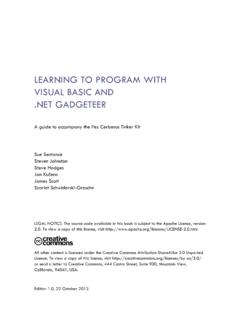Transcription of Everything you ever wanted to know about VB6 Colors
1 Everything you ever wanted to know about VB6 Colors Everything you wanted to know about visual Basic 6 Colors The topic of beautifying your visual Basic program is always a popular one in my classes. If you are like most of my visual Basic students, right about now you are clamoring to make your programs prettier. Personally, I'm pretty much a believer in accepting the default Colors that visual Basic assigns. As you will see during the course of the book, these default Colors are the Colors the user has selected in the Control Panel of their PC. But invariably, beginners love to experiment with features such as Colors and Font styles. So these are the topics I'll cover in this handout. Colors During the course of the book you'll see that many of the objects in visual Basic have color properties---most notably, the BackColor and ForeColor properties.
2 Again, if you accept the default values for these properties, your object will exhibit the same Colors that the user has selected in their Windows Control Panel. Most importantly, if the user then changes their color selections, the Colors in your program will change accordingly. Is there a default color ? Yes, each object in visual Basic that has a color property already has a default value established for it when you create the control. Let's take a look at these default values now. If you want, while you're reading about the default Colors , place some controls on a from. How about a Command Button, label, text box, list box, CheckBox, and an option button? Now bring up the Properties Window and examine the value for the BackColor property of the form.
3 What do you see? (1 of 15)3/28/2004 11:45:28 AM. Everything you ever wanted to know about VB6 Colors Here's the number that I see in the Properties Window. &H8000000F&. If you have already read Handout B, which is my handout on the various number systems in use in the computer, then you recognize this number as a Hexadecimal number. But what exactly does it mean? What is that funny number? The format of this number may appear familiar to you. We saw in Handout B that the &H combination indicates that this number is a Hexadecimal numbers. The rest of the number I'll discuss in just a few moments. My point is that visual Basic establishes a default value for the color property of your form and any control you place on the form.
4 How does visual Basic know what the default value should be? It looks for the user's color preference in their Control Panel. Naturally, the user's preferred color selections will vary from machine to machine. But the default value for the BackColor property won't change, as it just refers to the Control Panel value. Here's a screen shot from my Control Panel to show you what I mean. (2 of 15)3/28/2004 11:45:28 AM. Everything you ever wanted to know about VB6 Colors The default value for the BackColor of the form is always &H8000000F&, although the actual color that this value represents may vary from computer to computer. According to the visual Basic documentation, this number tells visual Basic to look up the color that the user has specified in the Windows Control panel for the WindowBackground setting.
5 For the ForeColor property of the form, again according to the visual Basic documentation, visual Basic uses the 'Window Text' color selection in the Windows Control Panel. I did a little experiment, which you'll repeat yourself later, where I. noted the BackColor and ForeColor properties of the Form and the controls that we'll discuss during our course. Here's a chart I have prepared based on that experiment. (3 of 15)3/28/2004 11:45:28 AM. Everything you ever wanted to know about VB6 Colors BackColor ForeColor Object Property Property CheckBox &H8000000F& &H80000012&. Command &H8000000F& None Button Form &H8000000F& &H80000012&. Frame &H8000000F& &H80000012&. Image None None Label &H8000000F& &H80000012&.
6 ListBox &H80000005& &H80000008&. Option &H8000000F& &H80000012&. Button PictureBox &H8000000F& &H80000012&. Textbox &H80000005& &H80000008&. Now the natural question to ask at this point is, how do you know what these numbers correspond to in the Control Panel. That's what this chart tells you. I developed this chart by accessing the visual Basic Object Browser. System color Hex Value Description Constant Scroll bar vbScrollBars &H80000000. color . vbDesktop &H80000001 Desktop color . color of the vbActiveTitleBar &H80000002 title bar for the active window. color of the title bar for the vbInactiveTitleBar &H80000003. inactive window. Menu vbMenuBar &H80000004 background color . Window vbWindowBackground &H80000005 background color .
7 (4 of 15)3/28/2004 11:45:28 AM. Everything you ever wanted to know about VB6 Colors Window frame vbWindowFrame &H80000006. color . color of text vbMenuText &H80000007. on menus. color of text in vbWindowText &H80000008. windows. color of text in caption, size vbTitleBarText &H80000009. box, and scroll arrow. Border color vbActiveBorder &H8000000A of active window. Border color vbInactiveBorder &H8000000B of inactive window. Background color of multiple- vbApplicationWorkspace &H8000000C document interface (MDI). applications. Background color of items vbHighlight &H8000000D. selected in a control. Text color of vbHighlightText &H8000000E items selected in a control. color of shading on vbButtonFace &H8000000F the face of command buttons.
8 color of shading on vbButtonShadow &H80000010 the edge of command buttons. (5 of 15)3/28/2004 11:45:28 AM. Everything you ever wanted to know about VB6 Colors Grayed vbGrayText &H80000011 (disabled). text. Text color on vbButtonText &H80000012. push buttons. color of text in vbInactiveCaptionText &H80000013 an inactive caption. Highlight color vb3 DHighlight &H80000014 for 3D display elements. Darkest shadow color vb3 DDKS hadow &H80000015. for 3D display elements. Second lightest of the vb3 DLight &H80000016. 3D Colors after vb3 DHighlight. color of text in vbInfoText &H80000017. ToolTips. Background vbInfoBackground &H80000018 color of ToolTips. The chart shows the visual Basic System color Constant, along with its Hex value, and what the value means.
9 I'll discuss color Constants in just a few moments. For now, suffice to say that a visual Basic color Constant is just an easier way to remember a long Hexadecimal number, and its name can be used interchangeable with the value in visual Basic code. Note here that the value for the BackColor of the form (&H80000F). according to visual Basic's documentation should correspond to the WindowBackground setting in the Control Panel. However, the Object Browser's description for the color Constant indicates that this value is the setting for the user's selection for the color of a Command Button. (6 of 15)3/28/2004 11:45:28 AM. Everything you ever wanted to know about VB6 Colors Pixels Yes, you've seen and heard this term before.
10 Pixels are the dots that form the characters and graphics displayed on your computer's monitors. Pixels are also a unit of measurement for computer monitors. For instance, your display monitor may display 800 pixels horizontally and 600 vertically. Pixels are varied in intensity and color to display the many beautiful Colors that you see on your computer's monitor. A single pixel is capable of displaying over 16 million different Colors by combining varying proportions of Red, Green and Blue (more on that later). When color monitors were first introduced, there was a brief period of time when the Colors on a display monitor were produced by combining three pixels. With today's modern technology, combining pixels in this way to form Colors is not necessary, but this is something you should bear in mind if you are writing a program for a user with an older computer, and you choose a color other than the default color schemes.


